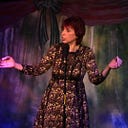Member-only story
Making It Work: Adapting Improv For Career Readiness With The Visually Diverse

Improv is the art of making things work, taking stock of “what is” and imagining “what if,” sometimes in the same beat. The imaginative agility that improv cultivates is increasingly recognized as invaluable in today’s workplace, when the pace of change and new information continue to accelerate. One human reality that has not changed is the impact of bias, which blocks awareness and acceptance of important facts. People who are blind or have low vision, confront this bias every day. Despite remarkable, accessible advances in technology that empower people with visual impairments to perform and compete in the workplace, more than half of the U.S. population of people with visual impairments are not in the labor force, simply because of bias and misinformation.
To address this bias, Perkins School For The Blind — the 2nd oldest school for the blind in the world, teaching people who are visually impaired and deaf/blind — created Career Launch @ Perkins, a 14-month career services training program for adults, when they recognized the drop-off of services for people once they finish high school. “In addition to our Career Launch groups, our program does advocacy to address the black-hole of knowledge that exists in the corporate community and get people up to speed on the fact that there is a talent pool here that they are missing,” says Deana Criess, Teacher of Applied Improv in the program.
After 20 years as an educator and improviser, Criess describes experiencing new joy as she works on “solving the puzzle of first taking the improv exercises originally designed for sighted folks, and making them work for people with varying levels of vision or no vision at all.” It is a daunting challenge. “All terminology that experienced improvisers know and love — even the very sacred ‘circle up’ — has to be broken down into information that is non-visual,” she explains. “I go back and rethink how to describe every exercise, asking myself ‘if I didn’t have the visual cues, what information would I need to understand how to do an exercise?”
And she does find the work a joy. “I’m back in the place of discovery,” she says. “Every time we have a session, there is something I can discover. We are all creating something together. And every session, even if I…
